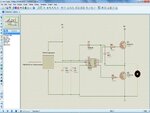adnan012
Advanced Member level 1
hi,
I am working on VFD to control the speed of a 5HP 3 phase induction motor using V\F technique. I need help in designing RC snubbers.
DC bus is 400V.
IGBT used is IRG4PC50W
Switching frequency 20KHz.
I am working on VFD to control the speed of a 5HP 3 phase induction motor using V\F technique. I need help in designing RC snubbers.
DC bus is 400V.
IGBT used is IRG4PC50W
Switching frequency 20KHz.
